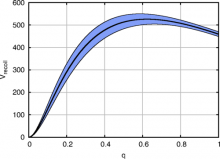
Abstract
We perform a set of 36 nonprecessing black-hole binary simulations with spins either aligned or counteraligned with the orbital angular momentum in order to model the final mass, spin, and recoil of the merged black hole as a function of the individual black hole spin magnitudes and the mass ratio of the progenitors. We find that the maximum recoil for these configurations is Vmax=526±23km/s, which occurs when the progenitor spins are maximal, the mass ratio is qmax=m1/m2=0.623±0.038, the smaller black-hole spin is aligned with the orbital angular momentum, and the larger black-hole spin is counteraligned (α1=−α2=1). This maximum recoil is about 80km/s larger than previous estimates, but most importantly, because the maximum occurs for smaller mass ratios, the probability for a merging binary to recoil faster than 400km/s can be as large as 17%, while the probability for recoils faster than 250km/s can be as large as 45%. We provide explicit phenomenological formulas for the final mass, spin, and recoil as a function of the individual BH spins and the mass difference between the two black holes. Here we include terms up through fourth-order in the initial spins and mass difference, and find excellent agreement (within a few percent) with independent results available in the literature. The maximum radiated energy is Erad/m≈11.3% and final spin αmaxrem≈0.952 for equal mass, aligned maximally spinning binaries.